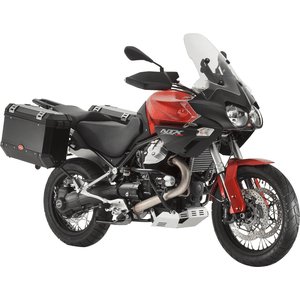Moto Guzzi Stelvio 1200 (2008–2010): A Transverse V-Twin Adventure with Italian Soul
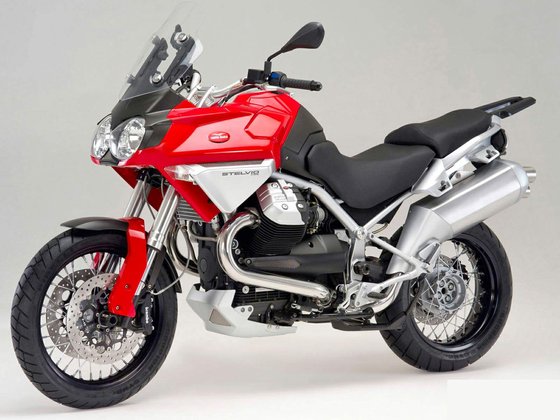
Introduction
The Moto Guzzi Stelvio 1200, produced between 2008 and 2010, remains a cult favorite among riders who crave a blend of Italian flair, long-distance comfort, and off-road ambition. Named after the infamous Stelvio Pass in the Italian Alps—a serpentine road with 84 hairpin bends—this maxi-enduro was designed to conquer both tarmac and gravel with equal confidence. While its production run was short, the Stelvio 1200 left an indelible mark as a charismatic alternative to mainstream adventure bikes. Let’s dive into what makes this machine stand out, even when viewed through a modern lens.
Design & Ergonomics: Form Meets Functionality
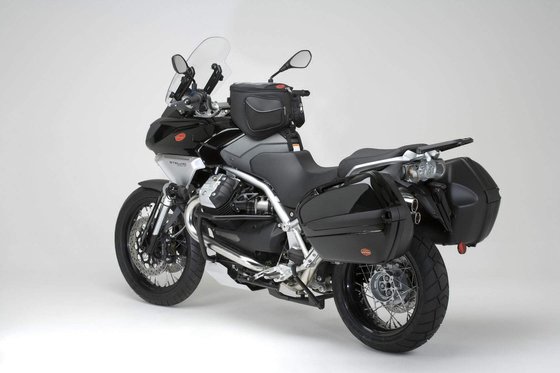
The Stelvio 1200’s design is a masterclass in balancing ruggedness with elegance. Its upright stance, sculpted fuel tank, and twin round headlights evoke a classic enduro aesthetic, but with a distinctly Italian twist. The 19-inch front wheel (110/90-R19) and 17-inch rear (180/55-R17) sit on spoked tubeless rims, hinting at its off-road intentions, while the 210 mm (8.3 inches) of ground clearance ensures rocky trails won’t faze it.
Key Highlights:
- Adjustable Ergonomics: The seat height can be lowered from 840 mm (33.1 inches) to 820 mm (32.3 inches), accommodating shorter riders without sacrificing ground clearance. The handlebar and windscreen are also adjustable, making it easy to find a comfortable riding position.
- Practical Touches: A lockable glovebox integrated into the tank (operable via handlebar button) and pre-installed luggage racks showcase Moto Guzzi’s focus on touring practicality.
- Aerodynamic Protection: The adjustable windscreen and handguards deflect wind effectively, reducing fatigue on long hauls.
The Stelvio’s 18-liter (4.76-gallon) fuel tank and 251 kg (553.3 lbs) dry weight give it a substantial presence, but the weight is carried low thanks to the longitudinal V-twin engine layout. This design choice aids maneuverability despite the bike’s heft.
Engine & Performance: The Heart of the Matter
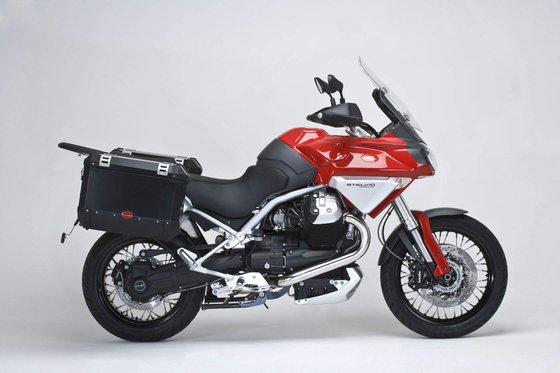
At the core of the Stelvio 1200 lies its air-cooled 1,151 cc 90° V-twin engine—a hallmark of Moto Guzzi’s engineering. With 105–108 HP (77–79 kW) at 7,250–7,500 RPM and a robust 113 Nm (83.3 lb-ft) of torque peaking at 5,800 RPM, this powerplant thrives in the mid-range.
Riding Impressions:
- Torque for Days: The engine’s meaty torque curve makes overtaking effortless, and the shaft drive delivers power smoothly without the chain snatch typical of adventure bikes.
- Characterful Sound: The transverse V-twin’s growl is unmistakable, amplified by a stainless-steel exhaust that’s refined but never obnoxious.
- Off-Road Limitations: While the engine’s low-end grunt helps on dirt, the shaft drive’s inherent weight and reduced rear suspension feedback compared to chain-driven rivals can make technical off-roading feel cumbersome.
The 6-speed gearbox is precise, though the clutch lever requires a firm pull—a common trait of single-plate setups. Fuel injection (Weber-Marelli) is seamless in most conditions, though cold starts occasionally demand a gentle throttle hand.
Handling & Ride Comfort: Tarmac Bias, Gravel Capable
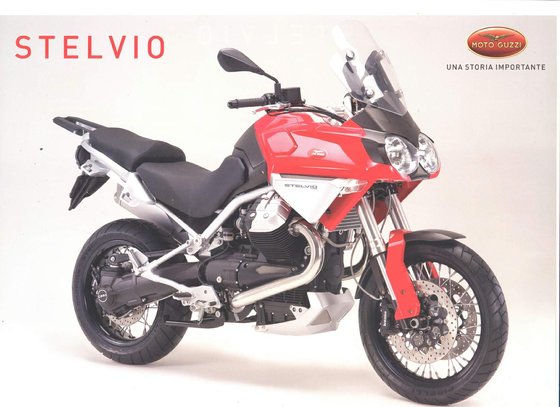
The Stelvio’s chassis is a tubular steel twin-cradle frame with a 27° rake and 125 mm (4.9 inches) of trail, striking a balance between stability and agility. Fully adjustable Marzocchi USD forks (170 mm / 6.7 inches of travel) and a Sachs rear monoshock (155 mm / 6.1 inches) handle bumps admirably, though the setup leans toward plushness over outright off-road aggression.
On the Road:
- Confidence in Corners: The bike carves through switchbacks with surprising poise for its size, aided by the Pirelli Scorpion tires’ sticky grip.
- High-Speed Stability: The 1,535 mm (60.4-inch) wheelbase keeps things planted at highway speeds, even with a full load.
Off the Beaten Path:
- Ground Clearance: 210 mm (8.3 inches) is ample for light trails, but the exhaust and cylinder heads are vulnerable to rocks. Aftermarket crash bars (available at MOTOPARTS.store) are a wise investment.
- Weight Distribution: The longitudinal engine keeps the center of gravity low, but the 251 kg (553 lbs) wet weight becomes apparent in deep sand or mud.
Technology & Features: Ahead of Its Time
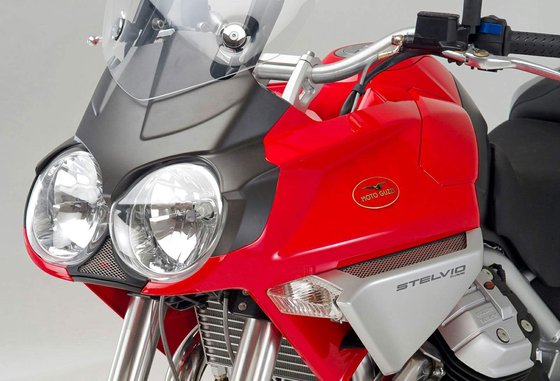
For a late-2000s motorcycle, the Stelvio 1200 packs impressive tech:
- Radial Brembo Brakes: Dual 320 mm front discs with 4-piston calipers and ABS (optional on earlier models) provide strong, predictable stopping power.
- Adjustable Suspension: Fine-tuning compression/rebound damping and preload transforms the bike from a tourer to a weekend trail explorer.
- Instrument Cluster: An analog tachometer pairs with a digital display showing fuel economy, trip data, and even heated grip settings (optional).
While lacking modern amenities like ride modes or TFT screens, the Stelvio’s simplicity is a virtue—fewer electronics mean fewer failures in remote areas.
Competition: How Does It Stack Up?
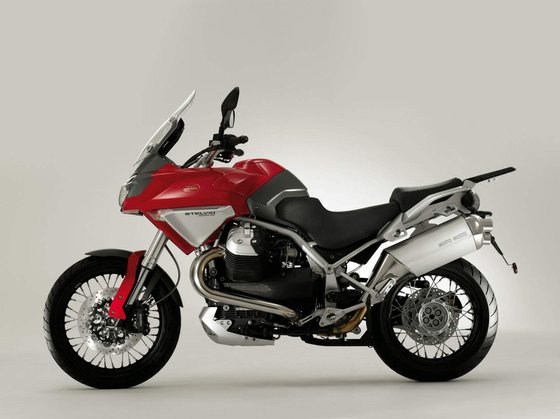
The Stelvio 1200 faced fierce rivals in the adventure segment. Here’s how it compares:
| Model | Engine | Weight | Torque | Key Advantages |
|----------------------|------------------|------------------|------------------|---------------------------------------------|
| Moto Guzzi Stelvio 1200 | 1,151 cc V-twin | 251 kg (553 lbs) | 113 Nm @ 5,800 RPM | Shaft drive reliability, Italian character |
| BMW R1200GS | 1,170 cc Boxer | 229 kg (505 lbs) | 115 Nm @ 6,000 RPM | Lighter, superior aftermarket support |
| Triumph Tiger 1050 | 1,050 cc Triple | 198 kg (437 lbs) | 100 Nm @ 6,250 RPM | Nimble handling, sporty performance |
| Ducati Multistrada 1200 | 1,198 cc L-twin | 189 kg (417 lbs) | 118 Nm @ 7,500 RPM | Cutting-edge tech, razor-sharp dynamics |
Verdict: The Stelvio trades outright agility for soulful engine character and shaft-driven durability. It’s less polished than the BMW or Ducati but appeals to riders seeking mechanical authenticity. The Triumph and Ducati outperform on pavement, while the BMW dominates off-road. Yet, none match the Stelvio’s charisma.
Maintenance: Keeping the Italian Stallion Roaring
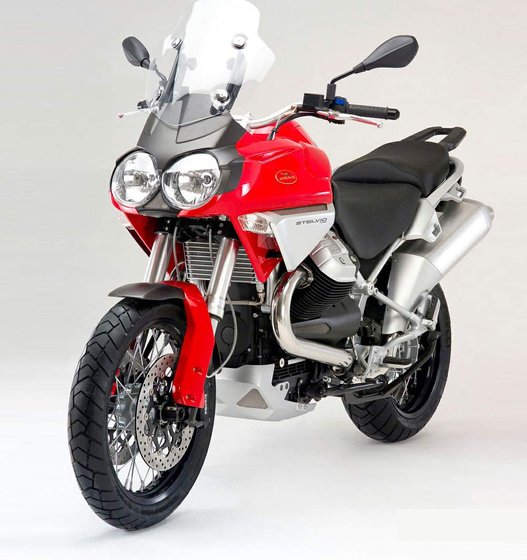
Owning a Stelvio 1200 requires attention to its unique quirks:
- Valve Adjustments: Every 12,000 km (7,500 miles), check the valve clearances (intake: 0.10 mm / 0.004 in, exhaust: 0.15 mm / 0.006 in). The transverse engine layout simplifies access.
- Shaft Drive Care: Lubricate the final drive every 10,000 km (6,200 miles) with SAE 85W-90 gear oil. Shaft systems require less maintenance than chains but demand periodic inspections.
- Oil Changes: Use SAE 10W-60 synthetic oil (3.5 liters with filter) every 6,000 km (3,700 miles). The air/oil-cooled engine runs hot, so quality oil is critical.
- Suspension Tuning: Rebuild forks and shock every 30,000 km (18,600 miles) to maintain plushness. Upgrade springs for heavier loads (available at MOTOPARTS.store).
Recommended Upgrades:
- Crash Protection: Aluminum engine guards and skid plates.
- Luggage Systems: Hard panniers designed for the Stelvio’s frame.
- Seat Comfort: Gel inserts or aftermarket seats for marathon rides.
Conclusion: A Love Letter to Adventure
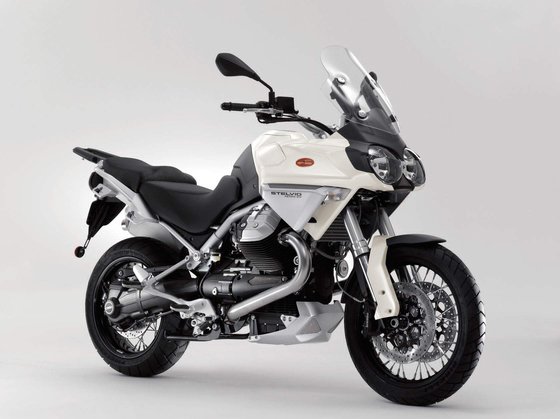
The Moto Guzzi Stelvio 1200 isn’t perfect—it’s heavy, thirstier than its peers (avg. 6.5 L/100 km or 36 mpg), and lacks modern tech. But its flaws are overshadowed by its personality. The transverse V-twin’s throb, the shaft drive’s elegance, and the bike’s ability to devour continents with style make it a timeless choice for riders who value passion over pragmatism.
Whether you’re tackling Alpine passes or navigating urban jungles, the Stelvio 1200 reminds us that motorcycling is about the journey, not just the destination. And with MOTOPARTS.store’s catalog of upgrades, this Italian legend can be tailored to conquer any road—or lack thereof.
Ready to enhance your Stelvio? Explore our curated selection of adventure-ready parts and accessories today.





Specifications sheet
| Engine | |
|---|---|
| Stroke: | Four-stroke |
| Max power: | 79 kW | 106.0 hp |
| Max torque: | 113 Nm |
| Fuel system: | Weber-Marelli electronic fuel injection with stepper motor control, Ø 50mm throttle bodies |
| Max power @: | 7500 rpm |
| Displacement: | 1151 ccm |
| Max torque @: | 5800 rpm |
| Bore x stroke: | 95.0 x 81.2 mm (3.7 x 3.2 in) |
| Configuration: | V |
| Cooling system: | Air/oil-cooled |
| Alternator output: | 550 W |
| Compression ratio: | 11.0:1 |
| Number of cylinders: | 2 |
| Dimensions | |
|---|---|
| Wheelbase: | 1535 mm (60.4 in) |
| Dry weight: | 214 |
| Wet weight: | 251 |
| Seat height: | 820-840 mm (32.3-33.1 in) adjustable |
| Overall width: | 920 mm (36.2 in) |
| Overall length: | 2250 mm (88.6 in) |
| Ground clearance: | 210 mm (8.3 in) |
| Fuel tank capacity: | 18 L (4.76 US gal) |
| Reserve fuel capacity: | 3.3 L (0.87 US gal) |
| Drivetrain | |
|---|---|
| Final drive: | shaft |
| Gear ratios: | ['1st: 2.235', '2nd: 1.700', '3rd: 1.348', '4th: 1.115', '5th: 0.968', '6th: 0.862'] |
| Transmission: | 6-speed |
| Maintenance | |
|---|---|
| Engine oil: | 10W60 |
| Idle speed: | 1100 ± 100 RPM |
| Brake fluid: | DOT 5.1 |
| Gearbox oil: | 500 ml SAE 80W-90 |
| Spark plugs: | NGK CR8EKB |
| Spark plug gap: | 0.7 |
| Tire pressures: | ['Front: 2.5 bar (36 psi)', 'Rear: 2.7 bar (39 psi)'] |
| Final drive oil: | 380 ml SAE 85W-90 |
| Engine oil capacity: | 3.5 |
| Engine oil change interval: | Every 5000 km or 2 years |
| Valve clearance (intake, cold): | 0.10 mm |
| Valve clearance check interval: | 24,000 km (15,000 mi) |
| Valve clearance (exhaust, cold): | 0.15 mm |
| Additional Features | |
|---|---|
| ABS: | Standard on all models |
| Wheels: | Tubeless spoked (19" front/17" rear) |
| Storage: | Lockable glove compartment with handlebar release |
| Instrumentation: | Digital dash with fuel computer, gear indicator, and heated grip control |
| Chassis and Suspension | |
|---|---|
| Rake: | 27° |
| Frame: | High tensile steel tubular twin cradle |
| Trail: | 125 mm (4.9 in) |
| Rear tire: | 180/55-17 |
| Front tire: | 110/80-19 |
| Rear brakes: | Single 282mm disc, 2-piston caliper (ABS) |
| Front brakes: | Dual 320mm discs, 4-piston radial calipers (ABS) |
| Rear suspension: | Progressive linkage monoshock (adjustable preload/rebound), 155mm travel |
| Front suspension: | 50mm USD adjustable forks (preload, compression, rebound), 170mm travel |



